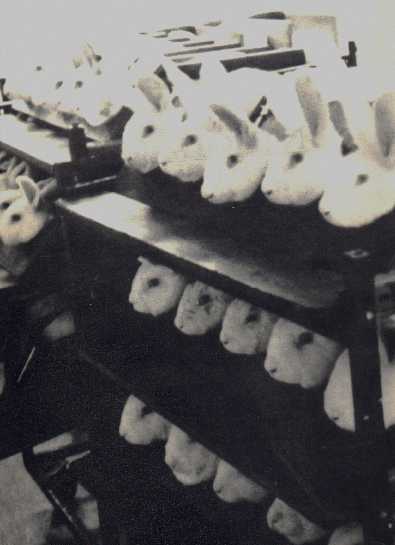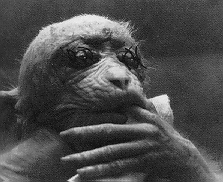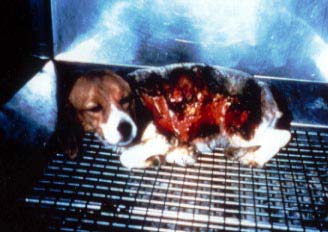"As an opthamologist, I
have no use for Draize test data because the rabbit eye differs from the
human eye." -- Stephen Kauffman, M.D., N.Y.U. Medical Center
TESTS AND PROCEDURES
Although many of the procedures these animals must
endure are not standardized, several have become notoriously well known,
both for their cruelty and their widespread usage. In 1998, over
two million animal experiments took place in Great Britain, sixty-five
percent of these using no anesthetic.
The Draize Test:
 Developed by John Draize, a FDA scientist, the Draize eye test measures
the harmfulness of chemicals found in household products and cosmetics.
Solutions are dripped or rubbed directly into the victim's eye, while the
eye is forcibly held open, sometimes with metal clips. The overall
effect is observed and dutifully recorded. The rabbits themselves
often suffer horrible pain, ulcerations, and possibly even blindness.
The test periods usually last in between three to twenty-one days, at the
end of which the animal is exterminated.
Developed by John Draize, a FDA scientist, the Draize eye test measures
the harmfulness of chemicals found in household products and cosmetics.
Solutions are dripped or rubbed directly into the victim's eye, while the
eye is forcibly held open, sometimes with metal clips. The overall
effect is observed and dutifully recorded. The rabbits themselves
often suffer horrible pain, ulcerations, and possibly even blindness.
The test periods usually last in between three to twenty-one days, at the
end of which the animal is exterminated.
LD50%:

LD50% stands for Lethal Dose, 50%. This
test is used to determine the toxicity of a certain substance. The
animals, used in large groups like the restrained rabbits at left, are
force-fed measured amounts of a substance until half (50%) of the subject
animals are dead.
Other Tests:
 This monkey, named "Britches" by the Animal Liberation Front, a corporation
who later rescued her, had her eyes sewn shut at birth so scientists could
study the reaction of an animal, blind from birth, suddenly being given
sight during a later point in her life. This experiment had no medical
value whatsoever other than to satisfy the curiosity of the scientists
themselves.
This monkey, named "Britches" by the Animal Liberation Front, a corporation
who later rescued her, had her eyes sewn shut at birth so scientists could
study the reaction of an animal, blind from birth, suddenly being given
sight during a later point in her life. This experiment had no medical
value whatsoever other than to satisfy the curiosity of the scientists
themselves.
 In tests for skin irritancy, animals are shaved and chemicals are rubbed
into their raw and abraded skin. They are restrained, like the rabbits
shown above, or caged, as is the beagle at left, so they cannot escape
the pain, as they are given no anesthetic. Many animals die trying
to escape their restraints.
In tests for skin irritancy, animals are shaved and chemicals are rubbed
into their raw and abraded skin. They are restrained, like the rabbits
shown above, or caged, as is the beagle at left, so they cannot escape
the pain, as they are given no anesthetic. Many animals die trying
to escape their restraints.
HOME
 Developed by John Draize, a FDA scientist, the Draize eye test measures
the harmfulness of chemicals found in household products and cosmetics.
Solutions are dripped or rubbed directly into the victim's eye, while the
eye is forcibly held open, sometimes with metal clips. The overall
effect is observed and dutifully recorded. The rabbits themselves
often suffer horrible pain, ulcerations, and possibly even blindness.
The test periods usually last in between three to twenty-one days, at the
end of which the animal is exterminated.
Developed by John Draize, a FDA scientist, the Draize eye test measures
the harmfulness of chemicals found in household products and cosmetics.
Solutions are dripped or rubbed directly into the victim's eye, while the
eye is forcibly held open, sometimes with metal clips. The overall
effect is observed and dutifully recorded. The rabbits themselves
often suffer horrible pain, ulcerations, and possibly even blindness.
The test periods usually last in between three to twenty-one days, at the
end of which the animal is exterminated.

 This monkey, named "Britches" by the Animal Liberation Front, a corporation
who later rescued her, had her eyes sewn shut at birth so scientists could
study the reaction of an animal, blind from birth, suddenly being given
sight during a later point in her life. This experiment had no medical
value whatsoever other than to satisfy the curiosity of the scientists
themselves.
This monkey, named "Britches" by the Animal Liberation Front, a corporation
who later rescued her, had her eyes sewn shut at birth so scientists could
study the reaction of an animal, blind from birth, suddenly being given
sight during a later point in her life. This experiment had no medical
value whatsoever other than to satisfy the curiosity of the scientists
themselves.
 In tests for skin irritancy, animals are shaved and chemicals are rubbed
into their raw and abraded skin. They are restrained, like the rabbits
shown above, or caged, as is the beagle at left, so they cannot escape
the pain, as they are given no anesthetic. Many animals die trying
to escape their restraints.
In tests for skin irritancy, animals are shaved and chemicals are rubbed
into their raw and abraded skin. They are restrained, like the rabbits
shown above, or caged, as is the beagle at left, so they cannot escape
the pain, as they are given no anesthetic. Many animals die trying
to escape their restraints.